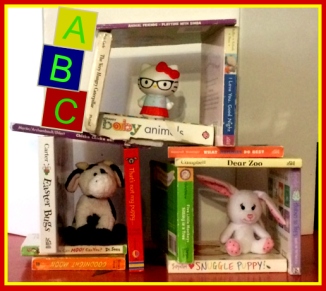I had the great pleasure of meeting Scholastic editor and children’s author Orli Zuravicky during the 2015 New Jersey SCBWI conference. Though it’s always a challenge to hold substantive conversations over the crowded lunch tables at these events, we did get a chance to discuss our mutual love of books that grab kids’ attention and hook on them on the experience of reading at a young age.
Orli was kind enough to find time in her very busy schedule to answer some questions about the books that appeal the most to the little ones – board books and novelty books. They truly are the building blocks to a lifelong love of books. Read on to find out more!
Katey: As both author and editor of books for young children, you must have a unique perspective on the qualities that make a board book stand out. What qualities or characteristics do you think contribute to great board books?
Orli: The board book market has become increasingly competitive in the last five years, which makes original board books tricky. However, if done well, they can be very successful. The strongest board books are the ones that tell great stories, and have multiple layers of learning for children to come back to time and again—an animal that appears subtly on every page, text that entertains the youngest readers with a repetitive refrain but can also resonate emotionally with the older toddler, etc.
Of course, there are some tried and true topics that have been popular in the board book market for years and continue to sell, such as good night books and books about love and the child/parent relationship, to name a couple. But the question to keep in mind is, how do you find the fresh take on these evergreen topics? If there’s one thing to take away from my answer, it’s layering!
Katey: Parents,teachers and caregivers want to buy books that kids will come back to over and over, and that will also be developmentally appropriate. What can they look for when selecting books for young children?
Orli: Children are constantly learning different skills at different times in their lives, so the first thing I would say is, don’t be deterred by the suggested age for a particular book or format. These age ranges are meant to be guidelines. However, while most seven and eight year-old kids aren’t reading picture books anymore, there is still a lot to be gained by reading picture books aloud to kids this age. There is a level of reading comprehension and an understanding of how a story relates to daily life that comes out of interactions during a read-aloud that doesn’t necessarily happen during a child’s independent reading time.
When looking for books for young readers, I would select a variety of different levels of difficulty. If readers are only given books that are challenging to read or slightly advanced, they may begin to view reading as a constant struggle and become turned off to it. If readers are allowed to stick to “easy” books, they won’t be challenged enough. It’s important to have a mix to develop that love of reading and to encourage proper development.
(A quick note from Katey: for more about choosing “Three Bears Books” – some easy, some hard,and some just right, click here. For more on reading picture books with older children, try this post.)
Likewise, I would encourage a variety of high-interest topics and topics you feel are important for your child to read for the same reason.
Katey: What trends are you seeing in interactive books for young kids? Any thoughts on what trends or new developments are just around the corner?
Orli: Novelty books are becoming more and more popular every season. There was a time when board books and novelty books would never get reviewed in the trade magazines, and now they are getting reviewed quite regularly. There’s a national spotlight on early education today that is brighter than ever before, and people are realizing just how impactful these formative years are—beginning at birth. The biggest trends and developments I see coming are simply that this category is growing daily and gaining more and more attention. With that attention, comes more opportunity!
Katey: What are some of your favorite new or upcoming books for young children?
Orli: I’m really excited about a number of books that I’ve worked on, which have all come out recently. I have two picture books that hit stores this summer (2015.)
The first is a wonderful school-related ABC book called ABC School’s for Me! written by the talented Susan B. Katz, a former teacher, and illustrated by bestselling artist Lynn Munsinger. It’s the perfect read-aloud for any child entering school (whether it’s pre-k or k).
The second picture book is called Pepper & Poe, written and illustrated by the talented Frann Preston-Gannon, who was the 2011 recipient of the Maurice Sendak Fellowship award.  Pepper & Poe, which received a starred review, is a hilarious sibling story about an old set-in-his-ways cat and a hyper new kitten. This book also teaches/reinforces the days of the week.
Pepper & Poe, which received a starred review, is a hilarious sibling story about an old set-in-his-ways cat and a hyper new kitten. This book also teaches/reinforces the days of the week.
Just launching this month is an extraordinary pop-up collaboration by musical duo, Musical Robo t, and bestselling author, illustrator, and pop-up engineer, David A. Carter, called If You’re a Robot and You Know It. It’s a futuristic twist on a tried-and-true song, with awesome pops and a free downloadable version of Musical Robot’s If You’re a Robot and You Know It song with purchase. This book has also received a starred review, and was given the Gold Award from the 2015 National Parenting Publications Awards.
t, and bestselling author, illustrator, and pop-up engineer, David A. Carter, called If You’re a Robot and You Know It. It’s a futuristic twist on a tried-and-true song, with awesome pops and a free downloadable version of Musical Robot’s If You’re a Robot and You Know It song with purchase. This book has also received a starred review, and was given the Gold Award from the 2015 National Parenting Publications Awards.
Katey: Any tips for caregivers reading with young children to help kids engage with the books and get the most out of the read-together experience?
Orli: Truthfully, you answered the question with the question, but I’ll reiterate it! Engage, engage, engage. Reading aloud is important, of course. But there’s a level of comprehension and understanding that occurs in the question and answer—in the conversations the stories spark—that has long-lasting effects. So, ask questions. Lots of questions. Talk about the story and what happened to make sure your child comprehends it. Find a way to relate the story you’re reading to his or her life. It’s these interactions that build strong pre-reading skills, and that ultimately raise strong readers!
Katey: Orli, thank you so much for your thoughtful answers, and for your sharing your insight with my readers! And readers, if you’d like to check out Orli’s own books, including the adorable Mister Doodle titles, I’ve got you covered. Read on for a quick bio that sums up just a bit of her awesomeness, and links to find her all over the internet!
Orli Zuravicky has been an author and editor in children’s publishing for over fourteen years. She is currently a Senior Editor at Scholastic, where she acquires for Cartwheel Books, Scholastic Press Picture Books, Orchard Picture Books, Scholastic Readers, and Branches. As an editor, she specializes in board books, novelty books, and picture books for ages 0-6, as well as Readers and early chapter books. As a writer, she is currently working on her first middle grade fiction series. You can learn more about her at www.orlizuravicky.com. Twitter & Instagram: ozsaidso





Great interview! Loved learning more about board books/novelty books and, as always, love the theme of engaging young readers with different kinds of books and not looking at the suggested age range so much.
LikeLike
Thanks for reading and commenting, Annina! It’s great to hear from you.
LikeLike
This was a very interesting read! You’re fortunate to get an interview like this and it really does open up the possibilities when it comes to reading to your kids. I couldn’t agree more with the age recommendations on books, it really depends on your child and what they will enjoy. Pepper and Poe looks like a cute story! Ray xx #twinklytuesday
LikeLike
Thanks for dropping in to visit! I’m glad you found some good book suggestions and enjoyed the read. All the best!
LikeLike
Fab interview. We love all books but board ones and picture one’s are always a winner. Zach loves being asked what he can find on the page! Thanks for linking up with #TwinklyTuesday
LikeLiked by 1 person
And thank you, as ever, for dropping by and for keeping the linkup going! I find so many wonderful bloggers thru #TwinklyTuesday.
LikeLike